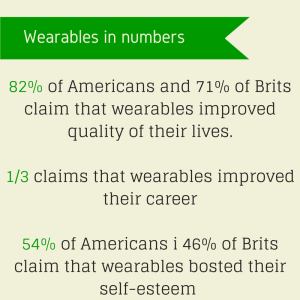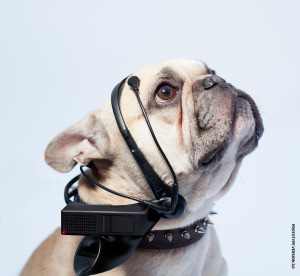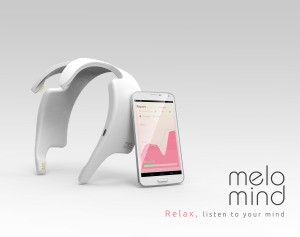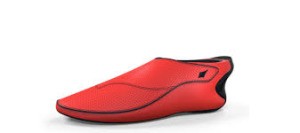2015 is critical for wearables: customers will decide whether wearables will be adopted broadly or will just remain a geek and trendsetter niche. Their becoming widely popular would mean big changes – also opening new, fascinating path for marketers.
What is a wearable?
The best definition of the term comes from Wired’s article by Thad Starner: wearables shorten time between intent and action. Do you want to record a moment? You don’t have to take out your camera or phone: Kapture or Autograph will automatically make a photo or video. Lost on your way? Google Glass will find the right track in the blink of an eye, or shoes connected to maps will lead you by vibrations in right or left shoe.
Wearbles statistics
According to experts, wearables market grows much more rapidly than previously estimated. Wearable users declare that smart objects:
- 82 percent of Americans and 71 percent of Brits said that cloud-powered devices have enhanced their lives.
- One in three respondents of both countries said that wearable tech has “helped their career development.
- 54 percent of Americans and 46 percent of Brits said wearable tech has boosted their self-confidence.

Centre for Creative and Social Technology at Goldsmiths, University of London research
(Centre for Creative and Social Technology at Goldsmiths, University of London)
Using wearables in marketing
- Can reduce role of mobile. Wearables will take part of the roles served by smartphones
- Will provide more data – prepare for processing huge amount of information
- More personalization. With more data on customers marketers will be able to match offers more precisely to their interest, particular moment and his localization (proximity marketing)
- We will all be covered with ads. Your smartwatch can advertise perfectly apps you use to other people.
- New forms of payment
- Triumph of applications. Leading smartwatches prefer apps over browsers, and each wearable has its own dedicated app. Therefore the role of applications will grow, changing the way we communicate with customers. Apps mean more exclusive relation, based on loyalty, when compared to browser use.
That’s what wearables can transform marketing. So let’s take a look at wearables themselves, in their most surprising forms.
1 Melomind – deep relax
A kind of a helmet that reads your neuronal activity to help you calm down. Using this device for 15 minutes per day can teach your brain how to loosen and let go all the tension that mounts in the body whole day. Thanks to that Melomind allows you to develop good resting and relaxation habits. As many start-ups, it tries to explore the power of neuroscience.
2 Sensory Fiction: a book to wear
MIT project: a book connected to a special vest allowing to feel with your senses what happens in the plot: shakes, temperature raising and dropping, slower or faster heartbeat, and changes in light or pressure (airbags in the vest create an effect of tightening, like in a tunnel). In the background of the project lies the idea that book – especially when compared to its younger brother, cinema – hasn’t changed much during its history. Is it an important medium in our contemporary world? Or maybe it grew old and without special effects and share buttons is just an archaic shadow of its former self, at the verge of extinction? Definitely thought-provoking one.
3 Ping – social media robe
Ping shows that technology and fashion are strange bedfellows. Ping – a sleeveless white and yellow robe – allows you to update your Facebook account with gestures. It also vibrates when you get a notification.
If you want to wear something different but equally social, go for Like a Hug Jacket. It tightens lightly when somebody likes your post on Facebook to make you feel as if you were hugged.
4 Smartest socks on Earth
Having difficulties when pairing your black socks? Solution is on the way. Blacksocks Smarter Socks Plus are black socks with sensors helping you to find matching socks and know when new socks should be bought.
Maybe you buy black sock in the very purpose of not having to pick the right one to match. Maybe they are cheaper methods of seeing whether your sock is worn out. Maybe 189 dollars for a pair of socks is too much.
5 Pet Pace Collar – how fit is your dog?
Fitness trackers are not only for humans! Measure your pet’s fitness and activity thanks to Pet Pace Collar. Hungry for more? Try GoProFetch – it allows you to install a camera on animal’s body, so you can see the world from its perspective. NoMoreWoof on the other hand does even more: basing on series of signals (neurological, temperature, pulse) will read pet’s mind. Real time human – pet translator!
6 Happiness Hat – never stop smiling
The project is a bit older than previous ones but shows endangers wearables and technology in general pose. Happiness Hat senses when you stop smiling and stabs you with little stud. You train yourself to smiling constantly. Say goodbye to frowned forehead! Is it exactly what you want? Laureen McCarthy’s object really makes you think if technology doesn’t offer you only superficial and in a long run harmful changes.
By the way: many customers treated it as an actual solution for everyday optimization. How can you consider buying a tool that stabs you?
7 Mood Ring – jewelry will tell you that do you feel
Does it happen to you not to know what do you feel? Now you can a remedy for that uncomfortable state: Mood Ring, an improved version of analog temperature-based mood rings. It reads your moods and displays them in an application, so you can control your emotions easily. There is no unconscious anymore. In your face, Sigmund Freud!
8 Neocomini – other will know your feelings also
When you know what you feel, it’s just the beginning. Fur ears on the band, Neocomini product, will not only read your mood, but also show it to others. If your mood is high (you’re excited, productive), ears go up, if you relax, ears go down. You will never have to worry that random strangers won’t get your emotions.
9 Arki – Ministry of Smart Walks
Arki bracelet – walking coach – ensures that your walking speed and posture are correct and healthy. Most of us walk badly: stoop-shouldered, shuffling, breathing poorly. Arki helps you unlock potential of long wanderings. Will you miss silly walks?
10 Emiota Belty – comfort for your guts
Belt hurting your belly after having a bit too much for diner? Not with Emiota. It adjust, adapts and does whatever is needed for comfort of your abdomen.
11 BitBite – classy chewing
Monitoring what you eat is easy. Monitoring how you eat – that’s more of a challenge. BitBite is a small device you put inside your ear, so it analyses your chewing habits. If you chew too fast, it alerts you – just like your nanny did.
12 Lechal – shoes will lead you
Now wearables don’t want to expose their technological side and try to appeal also to non-geeks who prefer more discreet design (although some users simply love to make loud statements about how serious are they about fitness – that’s why plasticky FitBit is still beloved). Lechal are map-connected haptic shoes, discreet in design, and you can also buy only insole. They guide you according to maps by vibrating in right or left insole. Useful for visually impaired and athletes.
13 Drum Pants – Music in your Pants
Set of small sound-generating devices you can wear wherever you like. That way you can make music all the time, no matter where you are. E.g. on a train.
14 Smart PJs – pajamas with a story
Ever run out of stories for your child to read? Smart PJs will help with that. Its pattern are really QR codes that will lead you to a bedtime story in dedicated application.
15 Odor sensor – don’t be a smelly friend
Malicious may say that it’s not a real patent Google filled for, but subtle way to tackle hygiene problems within the company. Planned device senses when you start to smell bad, informs you if your friends are nearing and sprays you with perfumed water.
Which one is the strangest to you? Let us know in comments
Read more:
- Why innovations fail? Case study of Nano car
- Work like a start-up, or Lean Marketing
- Most interesting start-ups of 2015
- Our ebook on Internet of Things



 Follow
Follow
















